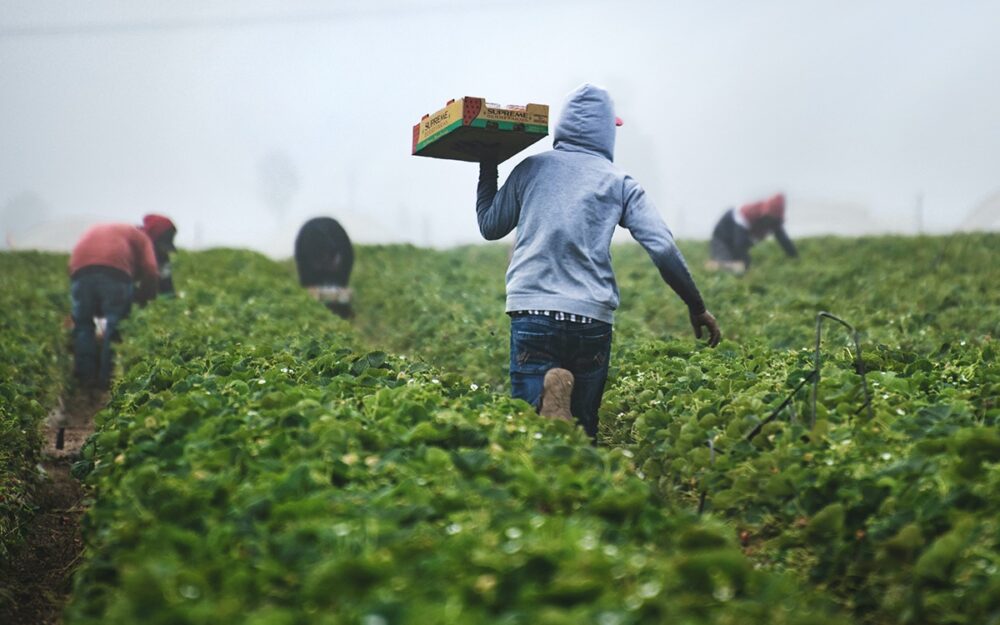
Noe Bautista is a Mexican-born farmworker and health advocate living in Polk County, FL. For him, farm work is a family tradition. When he was younger, he and his family followed harvesting seasons throughout the year. They started in Florida and migrated to other areas—North Carolina for strawberry season, Ohio and New Jersey for blueberries and cucumbers. It was hard work that required laboring long hours under the sun, exposed to potential health risks like dust and pesticides.
After high school, Bautista joined a job corps center and became a medical assistant, the first step into his eventual role as a farmworker health advocate. “I realized that there’s a lot of need for farmworkers, and there’s a lack of help,” said Bautista.
And he’s not wrong.
Agricultural farming has always been difficult, often dangerous work. Today, it’s even more hazardous due to climate change and the resulting extreme weather and natural disasters, such as dust storms, wildfires, flooding, and increasingly unpredictable harvest conditions. It doesn’t help that the agricultural industry is one of the biggest contributors to air pollution, making dust exposure particularly hazardous for farmworkers.
These conditions disproportionately impact agricultural workers, many of whom are seasonal and migrant farmworkers. They often face the biggest hurdles in obtaining workplace protections and healthcare. While the number of US farms has declined by 30 percent over the past four decades, there’s been an increase in the number of people hired to help at large-scale industrial farms.
Overall, 70 percent of farmworkers in the United States today are immigrants, and in 2019, workers of Mexican origin, like Bautista’s family, made up the highest percentage of farm laborers, sorters, and graders. These worker groups are vulnerable to a deadly confluence of environmental and occupational hazards, such as long-term exposure to pesticides, heat stress, and musculoskeletal impacts—all of which could also have detrimental effects on their respiratory health.
Agricultural farming has always been difficult and often dangerous work. Today, it’s even more hazardous due to climate change and resulting extreme weather and natural disasters, such as dust storms, wildfires, flooding, and increasingly unpredictable harvest conditions.
Agricultural Dust and the Compounding Impacts
Agricultural pollution tends to come from two sources: livestock and crops. Activities such as harvesting grain create dust particles that can be a toxic mix of fumes, soil, and smoke. Human lungs have several defense mechanisms, but the cell-like dust particles can still penetrate the alveoli—tiny air sacs in the lungs—which do the important job of receiving oxygen and releasing carbon dioxide. Once dust particles reach those sacs, they can interfere with the body’s ability to absorb the former and release the latter, resulting in medical conditions like shortness of breath, asthma, and chronic bronchitis. Farm-specific illnesses can include organic toxic dust syndrome and farmers lung. Fifty percent of grain handlers suffer from symptoms of chronic bronchitis.
Dust exposure is dangerous under normal conditions, but the changing climate, extreme weather conditions, farming practices, and the ongoing pandemic only exacerbate the problem. In 2021, the University of Florida’s Department of Environmental and Global Health published a study on occupational air pollution and respiratory health in farmworkers. According to lead researcher and department assistant professor Eric S. Coker, farmworkers are typically hard to reach, with very little public health surveillance data.
Overall, 70 percent of farmworkers in the United States today are immigrants, and in 2019, workers of Mexican origin like Bautista’s family, made up the highest percentage of farm laborers, sorters, and graders.
Of the study’s focus populations, strawberry workers had the highest levels of exposure to dust because they work closest to the ground. “[Strawberry picking] is delicate work that requires a high skill level but comes with added risk,” said Coker.
California’s wildfires also increased dust levels. Similar to Florida, warming temperatures coupled with increasingly severe wildfires in and around the region are changing the farming landscape. Estella Cisneros, legal director of California Rural Legal Assistance (CRLA) Agricultural Workers program, notes that hot temperatures are appearing earlier each year, with summers getting “very hot.” This puts farmworkers at increased risk for not only heat stress but also the effects of wildfires, even if those fires aren’t in their immediate vicinity. Wildfire smoke is a mixture of soil, metals, dust particles, and other biological materials, and it can travel far. Workers could be exposed to the smoke and everything it carries, whether they’re in active fire zones or in areas the smoke has traveled.
Personal protective equipment (PPE) like masks could provide a measure of safety for farmworkers. According to Cisneros, California mandates require employers statewide to provide KN95 masks if the air quality index (AQI) is above a certain level. However, during the 2020 wildfire season and the height of the pandemic, the AQI exceeded 160, but farmworkers weren’t always provided with the mandated masks.
Sign up for our free newsletters
Subscribe to NPQ's newsletters to have our top stories delivered directly to your inbox.
By signing up, you agree to our privacy policy and terms of use, and to receive messages from NPQ and our partners.
Farmworkers will likely be the demographic that is impacted most by extreme heat and COVID-19. For example, in California’s Central Valley, if the temperature is between 95 and 100 degrees Fahrenheit, agricultural productivity is likely to decrease by 4 to 8 percent depending on how labor-intensive the crop is. From the start of the pandemic through March 2021, the decrease in farmworkers’ labor due to COVID-19 is estimated to be roughly a loss of $301 million. Besides extreme heat and dust exposure, overcrowded housing, shared transportation, and inadequate workplace training were the main risk factors identified by the National Center for Farmworker Health. To map, track and mitigate these risk factors, the NCFH created the migrant health center map which provides healthcare and continued treatment for migrant farmworkers.
Understanding some of the symptoms of respiratory illnesses as a result of dust exposure is what Coker wants to explore next. The hypothesis is that exposure to higher levels of dust, which includes some level of fine particulate matter PM2.5, does more than just irritate the lungs and penetrate alveolar sacs but can possibly get into the bloodstream. “So it’s a much more systemic, deep lung injury,” says Coker. This could lead to a higher inflammatory response which in the context of viral respiratory infections like COVID-19 is extremely important. According to Coker, “If you have this virus and exposure (to dust and air pollution) that’s chronic, the hypothesis is that bio-influenced respiratory infections will be more severe.”
Practices such as dryland farming, planting cover crops, and using drip irrigation can be adopted to make the industry safer and more climate resilient.
Another contributor to respiratory illness in farmworkers is the increased usage of pesticides. Many farmworkers often harvest by hand, with no gloves, due to how delicate some crops are, like strawberries and blueberries. Often, they pick and harvest in fields that increase their exposure risk to both dust and pesticides, which eventually weakens their immune response. And certain crops, like bell peppers and spinach, have high pesticide residue. “So, we know these workers are exposed, we just don’t know the levels, which is also of concern,” says Coker. This makes farmworkers more vulnerable to chemical-related injuries and illnesses than any other workforce nationwide.
Removing Barriers to Healthcare and Life-Saving Information
Bautista eventually became a lifeline to farmworker communities in Florida. He started a mobile health service—Unidad Móvil de Salud Orlando—which brings health screenings, preventative care, and other services right to farms around the state so that farmworkers can get better access to the resources they need. Farmworkers can get tested for diabetes, vision, blood pressure, and more, which are common ailments for that population. The questions Bautista always has on his mind: “What else do people need? What else can we give them?”
In addition to healthcare access, adaptive farming practices can also help keep farm workers safe. Practices such as dryland farming, planting cover crops, and using drip irrigation can be adopted to make the industry safer and more climate resilient. These methods promote water-efficient agriculture which can help lessen workers’ exposure to heat stress, and they offer natural mitigation of pests and diseases, dramatically lessening the need to use pesticides.
Advocacy can also play a role. Groups like Farmworker Justice and CRLA are approaching farmworker migrant rights using an intersectional approach that addresses these issues holistically and seeks to ensure better working conditions, protect immigration status, and consider the health factors and risks that go into this work.
Cisneros remembers a wildfire situation during that time in Fresno County, where she was living with her family. “I noticed that the agency that was responsible for informing residents of whether they were, in fact, in the active wildfire zone or not, was only sharing it in English,” says Cisneros. The need for language-accessible resources is critical to understand and minimize risk.
By understanding the language needs and technology access, Cisneros notes, “CRLA has this grassroots way of spreading out information.” This is especially focused on educating farmworker populations on how to protect themselves from environmental dangers, which, as the climate crisis continues, will be increasingly crucial.











